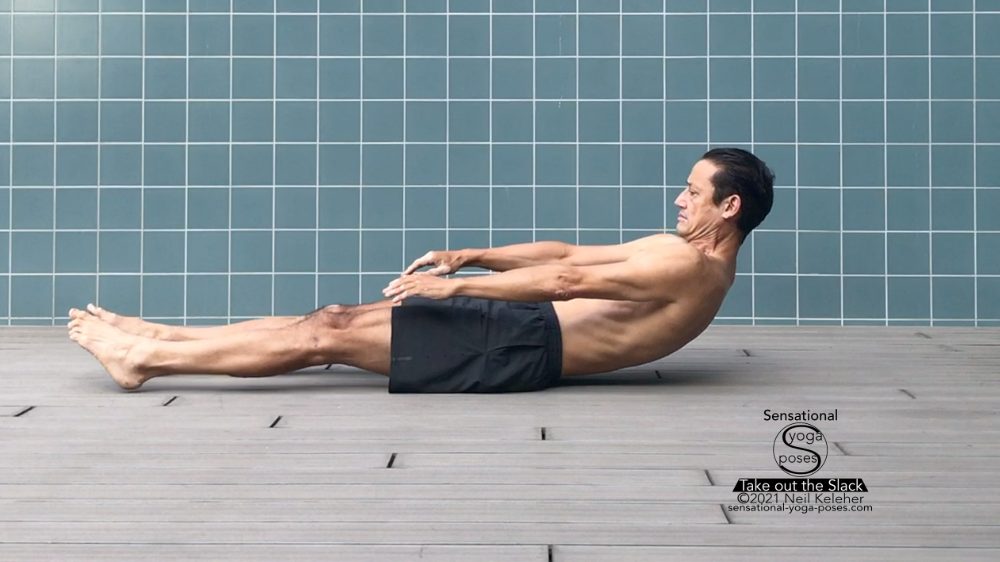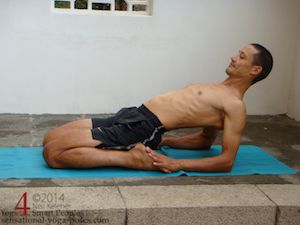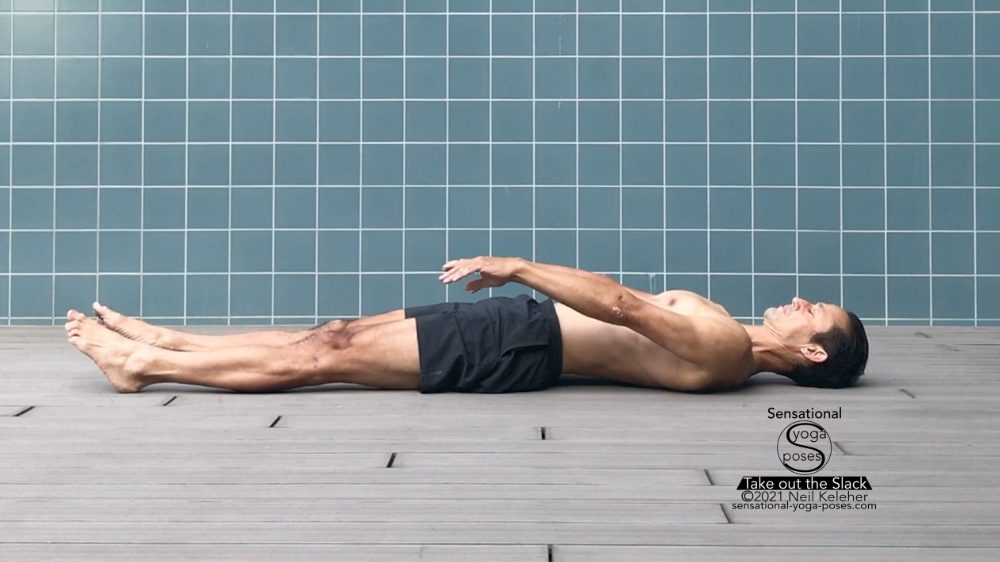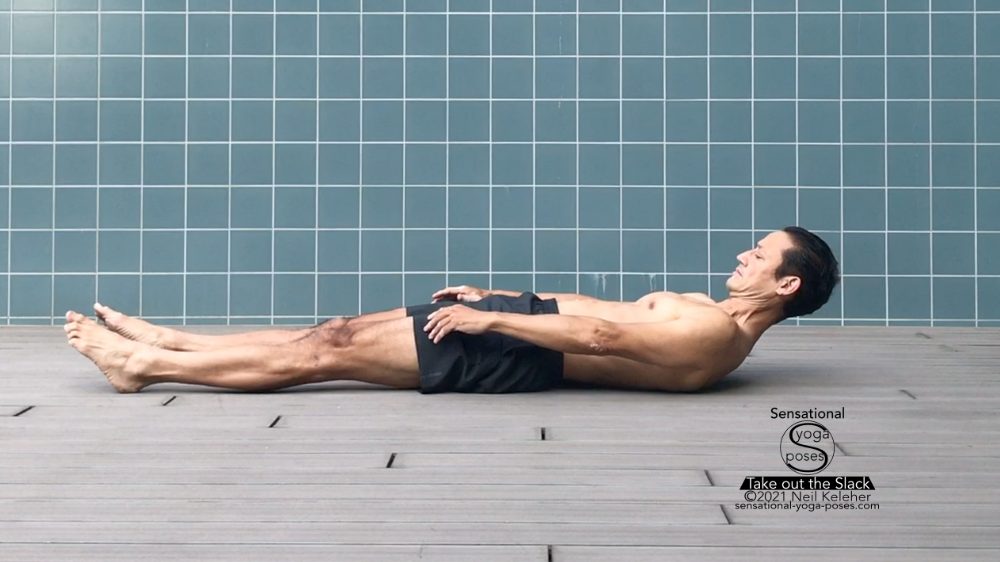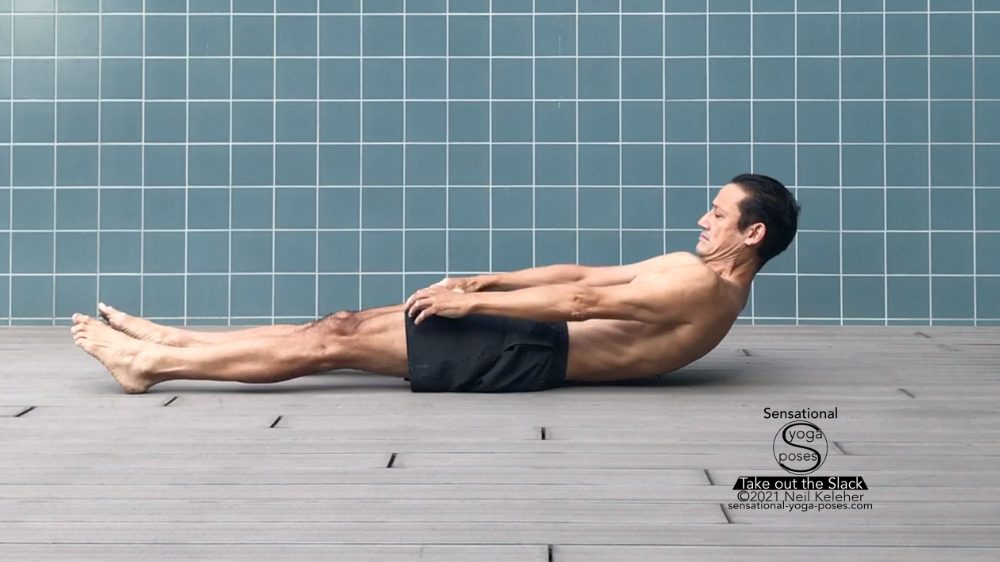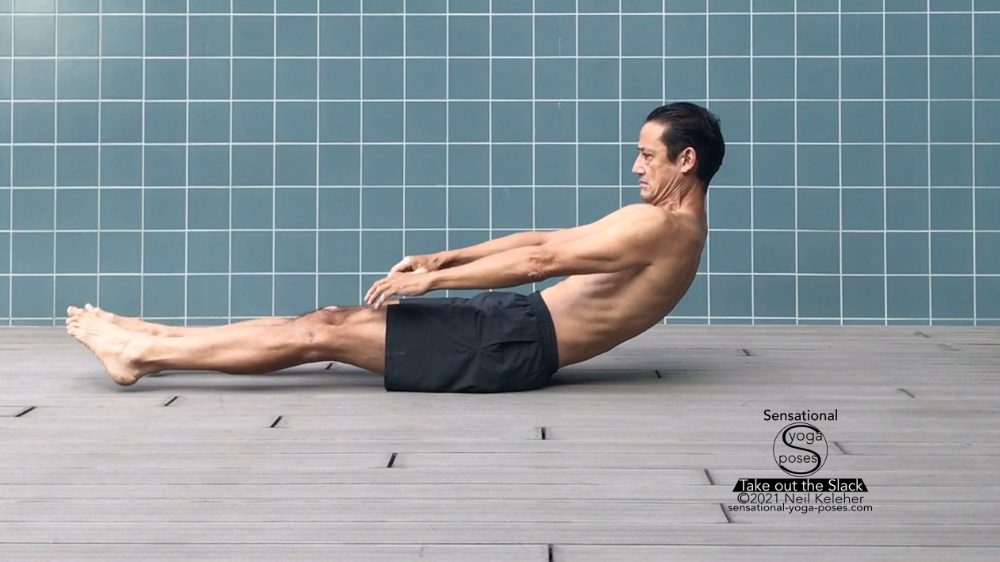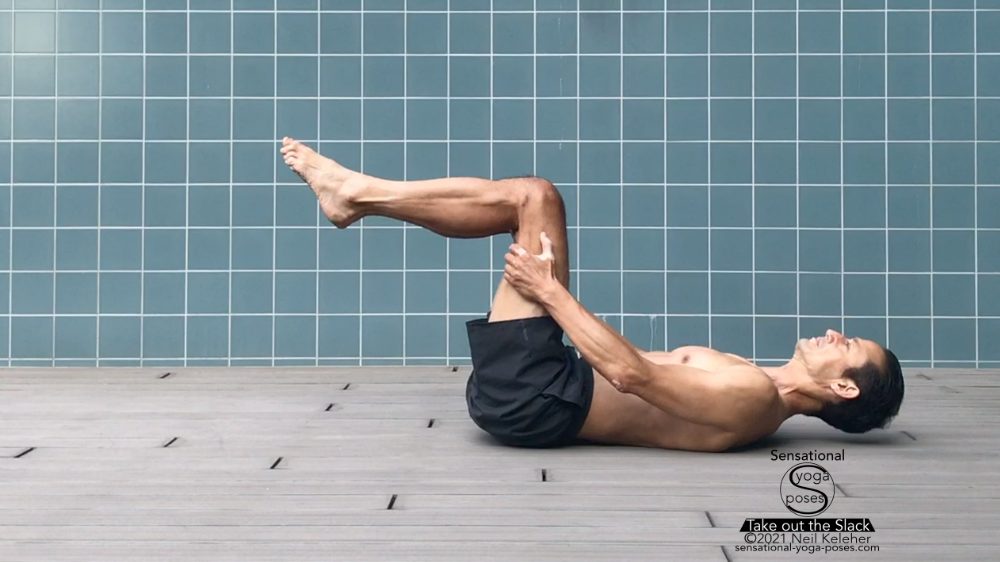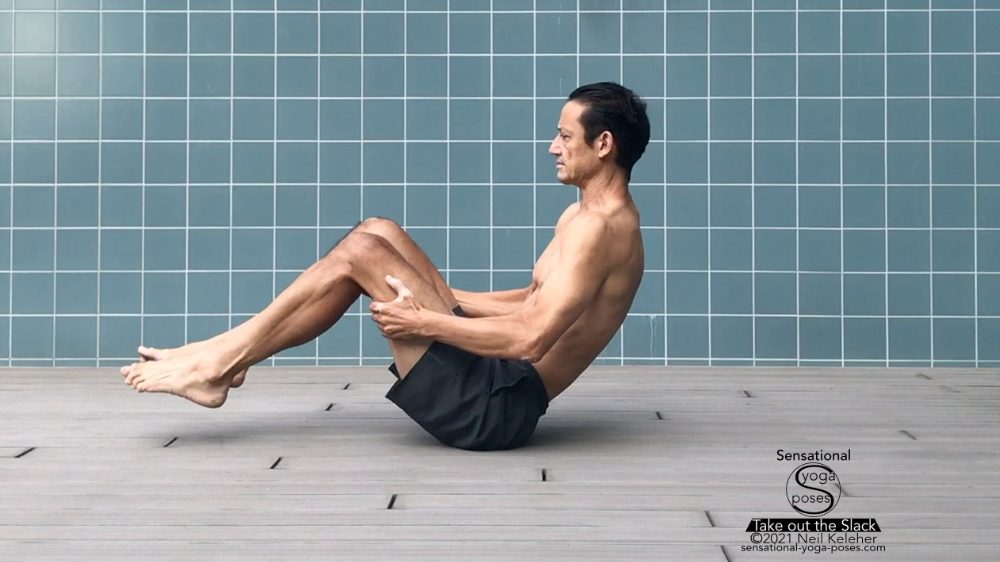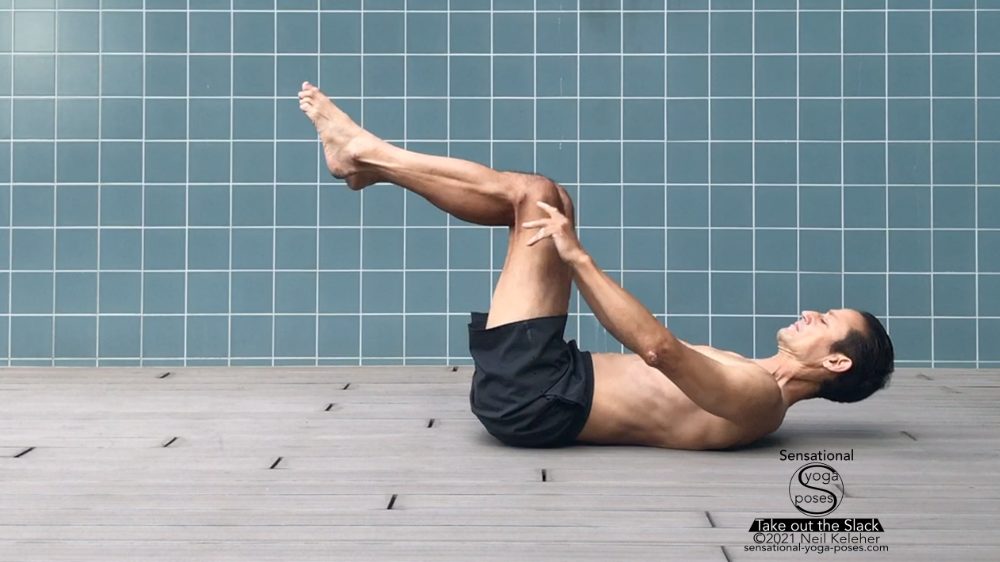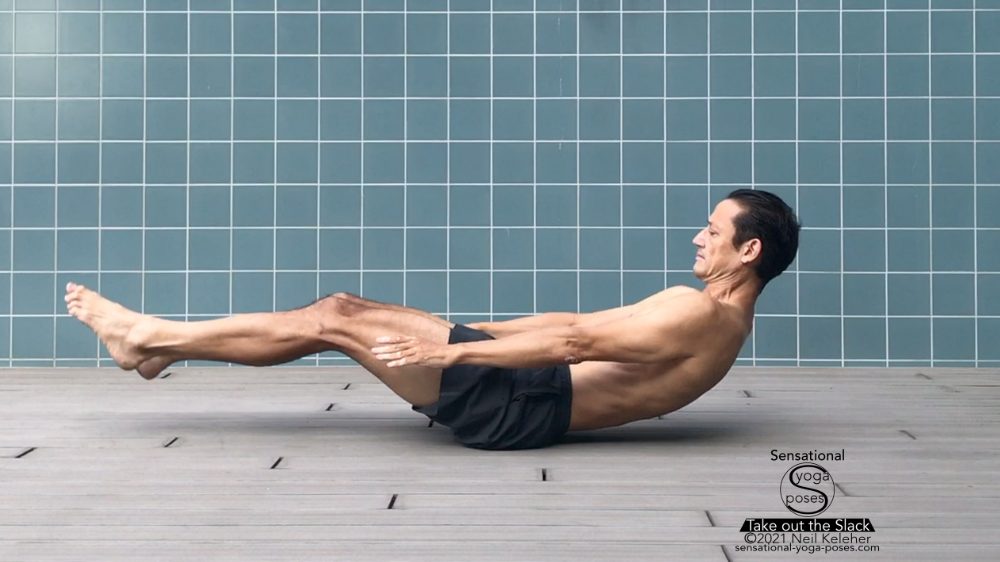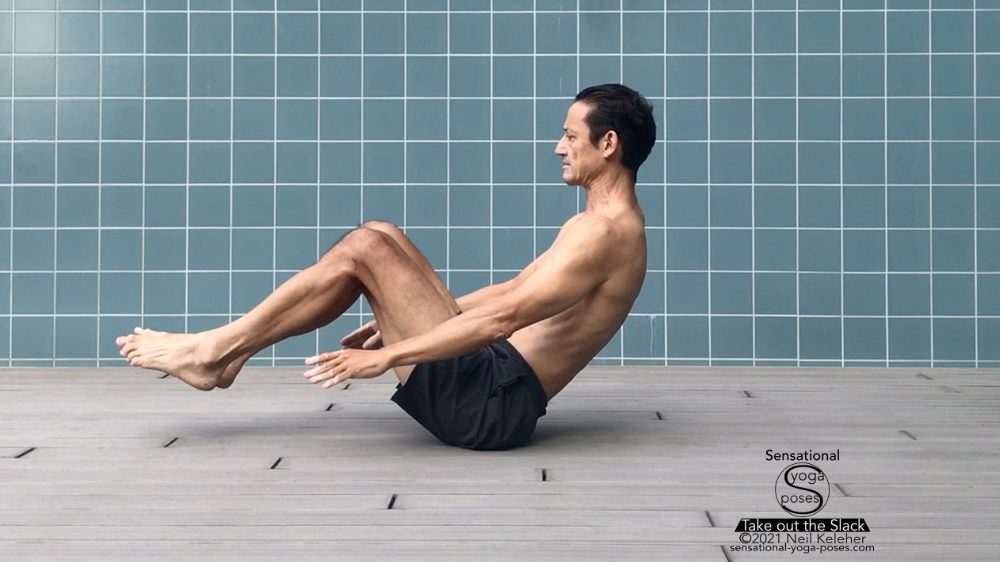Straight leg situps are one way of practicing sitting up
So let's say that you are an old person. You've landed flat on your back. How do you get up? Maybe you roll onto your side and then your belly and then push yourself upright, getting one knee and then the other underneath you. But let's say that you've practiced sitting up with legs straight. You can then simply straighten your legs and sit up.
Another option is to grab onto your thighs and kick your legs forwards to roll your self up to sitting.
The point here is that if you are on your back, then a straight leg sit up is one way of sitting up quickly and efficiently. What are other advantages of the straight leg sit up?
Straight leg sittups can be used to improve body awareness and control
Straight leg situps can be used to improve body awareness.
Can you peal your head and upper ribcage off of the floor slowly and smoothly, without jerking (or minimal jerking)? Can you lower yourself with the same control?
They can be used to help understand the idea of anchoring. For example, it is possible while lying down to lift the legs. It is also possible to do a sit up. What is different between these two actions?
Why in one case while lying down can we lift our legs and in the other our body. What do we change or what changes within our muscles and joints to allow us to choose between these two movements?
We can thus learn about relative mass and how we can "lock" bones together to change relative mass and thus anchor one part of the body or the other.
Straight leg situps can strengthen the abs and the hip flexors
A more basic advantage of practicing straight leg sit ups is that it can be used to to strengthen the hip flexors.
The straight leg sit up can also be used to strengthen the abs.
So, is there a danger to the low back when doing straight leg sit ups?
If there are pre-existing weaknesses, then yes you could hurt your back. Also, if you jump right into them with little or no prep work, then yes you could hurt yourself.
I've included some exercises that you can use to progress towards straight leg sit ups near the bottom of this page. No special equipment required. All you need is the floor, and maybe, if you find it uncomfortable laying on a hard floor, a mat.
Why straight leg situps were thought to be bad for the lower back
As far as I'm aware, what inspired the idea that straight leg sit ups are bad for the lower back was a research paper that looked at the fibers of the psoas in relative isolation. The paper in question suggests that the lower fibers of the psoas can exert a shear force on the lower lumbar vertebrae, basically pulling it forwards relative to the sacrum.
Note there are facet joints that connect the lumbar vertebrae and sacrum that can help resist such a force.
What lumbar shear can feel like
I'll say here that that shear force doesn't occur when doing straight leg situps.
That being said, I've noticed a sensation that could be equated to lumbar shear when lying back while kneeling with insufficient ab engagement.
Propping myself up with my arms as I lower myself backwards, it is relatively easy for my abs to turn off because my arms are supporting my upper body. And once I got my head on the floor, the same condition, relaxed abs can persist. The resulting sensation is distinct and highly uncomfortable. It's like pulling sensatin on the front of my lumbar spine and it is very uncomfortable, and not in a good way. It does feel like my lower back is being subject to a shear force.
I get nothing like it when doing straight leg situps.
That being said, still work towards straight leg situps gradually if just getting back into them or if doing them for the first time.
Why lying back while kneeling can cause lumbar shear
Now why does the lying back while in the kneeling position cause or potentially cause lumbar shear? Because in this position the rectus femoris pulls on the ASICs which then prevents the hip bone from tilting back. Thus while moving backwards, the lumbar spine lordosis increases. This creates a large angle between the front of the lumbar vertebrae and the front of the hip bones. Not only that, the front of the ribcage is unsupported. As a result, the psoas is bearing a lot of weight, and it in turn exerts a lot of force on the lower lumbar vertebrae.
Basically, it causes the sheer forces that the article in question alluded to.
That being said, if doing the same pose with the abs engaged (whether or not the arms on the floor), my lower back is a lot more comfortable.
Activating the abs helps to support the weight of the ribcage front the front. It also helps to reduce the amount of back bend in the lumbar spine. Just as importantly, the shearing sensation goes away when abs are activated.
Using the abs to reduce lumbar shear forces
One way to get the abs to activate is with a variation on that pose called bent back hero pose.
One reason for this is that the abs, the external obliques and rectus abdominis in particular, are helping to support some of the weight of the upper body. In addition, this load on the abs means that they are generating a force on the front of the hip bones, at the ASICs and pubic bone which helps to tilt the hip bones back.
So not only are the abs helping to support the weight of the upper body they are also helping to tilt the hip bones back. That in turn can help to flatten the lumbar curve reducing the severity of the angle at which the fibers of the psoas exert on the lumbar vertebrae.
Long explanation aside, it's much more comfortable on the lower back when the abs are engaged.
How activating the abs helps to anchor the Quadratus lumborum and/or the spinal erectors
Note that with the abs exerting a pull on the front of the hip bones, this means that the back of the hip bones experience a downwards pull (say towards the knees). This downwards force can help to anchor the quadratus lumborum (at least the fibers that attach to the back of the hip bone) as well as spinal erector muscles that attach from the hip bone to the lumbar vertebrae. These muscles can further help to counter any shearing forces on the lumbar spine.
Why lumbar shearing does not occur in straight leg situps
So why doesn't lumbar shear occur in straight leg situps?
For one thing, the knees are straight which means the rectus femoris isn't under so much stretch. That means the hip bones aren't prevented from tipping back. As a result, while lying flat on our backs on the ground, we can have a fairly "neutral" lumbar curve. We could, if we wanted to, even flatten it.
Plus, the whole purpose of a straight leg situp is to exercise the abs. They have to activate. As a result, they help to support the front of the ribcage. And in general, the further you sit up the more flat the lumbar curve becomes. The actual bending forwards of the lumbar spine helps it to resist any shearing forces from the psoas.
That isn't to say that you shouldn't just jump straight into doing them. When exploring new moves, or revisiting moves I haven't done in awhile, or just simply practicing body awareness, I tend to execute and teach movements using a slow and smooth rhythm.
This allows me to stop easily if I experience pain in any part of the movement.
As well as moving slowly and smoothly, I also tend to use, and teach specific muscle control techniques.
So for example if I do experience low back discomfort while doing straight leg situps, I'll change the way that I do them. For example, I'll try deliberately activating my transverse abdominis, or my quadratus lumborum, or as I'll talk about in a moment, my spinal erectors.
And if I still get pain, then I'll leave the exercise out.
The Jefferson curl (and how it's like a straight leg situp)
An exercise that is very similar in appearance to the straight leg sit up is called the Jefferson curl.
You stand upright while holding a barbell and bend the spine forwards from the top down one vertebrae at a time. Then you reverse the process to straighten back up.
Where straight leg situps exercise the abs, the Jefferson curl mainly works on the spinal erectors. That being said, while doing a Jefferson curl you could activate the abs also, particularly when using lighter weight.
Why activating the abs in a Jefferson curl can be helpful
Why activate your abs when doing a Jefferson curl, particularly if this exercise is to strengthen the spinal erectors?
Because by activating your abs, you give the spinal erectors a greater force to work against. As a result they have to activate more strongly to oppose this force. This results in the muscles on both sides of the spine (front and back) exerting against each other.
Why using opposing muscles against each other doesn't violate the mutual inhibition concept
But what about mutual inhibition I hear you say?
Mutual inhibition, where an anatogist or opposing muscle relaxes so that the agonist or working muscle can effectively shorten happens during ballistic movements.
When moving slowly and smoothly as is normally recommended for exercises like the Jefferson curl, opposing muscles can work together so that muscles on both sides of a joint are active, helping to support that joint and keep it safe and at the same time allowing those same muscles to share the load.
Why activating spinal erectors while sitting up is a good thing
You could do the same thing while doing straight leg sit ups. And here by "same thing" I mean activating muscles that you might think would actually hinder the movement. And so in straight leg situps you could try activating your spinal erectors prior to actually sitting up.
Since muscles need an opposing force to work against, and since opposing forces have to equal each other, the more you exert the spinal erectors, the more the abdominal muscles have to activate (assuming there are no other forces in play). The spine is then stabilized from front to back, and you may actually have an easier time doing a straight leg situp since the abdominals are already engaged.
Spinal dead spots and how to remove them
One thing that beginners are often told when doing the Jefferson curl is that there may be dead spots along the spine, or parts of the spine where it is difficult to isolate individual vertebral joints. And that's one thing that is nice about the straight leg situp. It's one way of practicing getting a smooth bend along a good portion of the spine.
That being said, an even better way to improve spinal awareness and mobility is to practice moving it in relative isolation while focusing on the individual joints. But prior to that a simple exercise that you can practice is making the entire spine feel long.
Better yet, isolate the parts and focus on lengthening them in relative isolation, i.e. lumbar spine, lower thoracic, upper thoracic, neck.
With straight leg situps you can then practice this spinal segmentation, at least for parts of the spine. Likewise with Jefferson curls.
Straight leg situp control options
As mentioned, one thing that you can do when working on a straight leg situp is to activate your spinal erectors first. Do this while keeping the body still. If you activate your spinal erectors without changing the shape of your spine, your abs will activate the oppose the backbending force that your spinal erectors activate. You can then use your abs to sit up.
Making the neck feel long
Another activation that I like to do with straight leg situps is to lengthen the neck.
The queue I like to use for this is to draw the ear holes away from the shoulders. If you focus on feeling your neck while doing this, you can notice when the back of your neck feels long. And you can also adjust the amount of ear hole pulling and even adjust the position of your head relative to your ribcage so that the back of your neck feels comfortably long.
This action might seem counter intuitive because you're lengthening your neck in the direction opposite to the one you want to go in. That being said, it activates the neck muscles and has an affect on the ribcage and the shoulders.
How lengthening the neck can help a straight leg situp
In general lengthening the neck tends to lift the front ribs while standing. This in turn helps to anchor the upper end of the abs and also increases the distance they span, adding tension to them by lengthening them. Doing this while lying down has a similiar affect and could be thought of as anchoring the abs from above while at the same time preparing them, by taking out the slack, so that they are ready to execute the sit up action.
Note that when pulling the head back and up, part of how it may bring the front ribs with it is via the muscles at the front of the neck. And so lengthening the neck while supine may be a way of taking out the slack from the anterior neck muscles. As a result, they are ready to lift the head when initiating the sit up.
The basics of sitting up with legs straight
With a straight leg situp the very basics are to activate or engage the feet, ankles and hips. This effectively makes the legs and hip bones a large anchor for the torso. With the legs anchored, you can then lift your head off of the floor.
From there you can then curly your upper back off of the floor.
Rather than just heaving the upper body off of the floor, the process is much like lowering down in a jefferson curl. The idea in this case is to bend the upper back forwards to peel it off of the floor.
Apart from obvious differences with the jefferson curl, I will say here that you don't have to bend your neck fowards one vertebrae at a time while doing a straight leg sit up. Though you can do so if you choose.
Doing the head lift first helps to shift the center of gravity of your upper body towards your feet. Curling the upper back off of the floor further shifts the head towards the toes. This then makes it possible to peel the rest of your torso off of the floor with minimal lifting of your legs.
Note, to reduce the chance of your legs lifting, you'll probably also have to reach towards your toes with your arms, protracting your shoulder blades as you do so.
Note when doing a straight leg situp, you don't have to sit all the way up. Basically, if you can get your back off of the floor, you'll be able to sit all the way up. And so I'll often stop when I've got my back completely off of the floor.
I'll then focus on lowering myself back down slowly, in control.
Lowering down slowly and in control
Often times with situps in general but also with the straight leg situp specifically, it's relatively easy just to flop back down. Another option is to lower down with as much control as sitting up.
And so one thing I like to pay particular attention to when lowering down is touching the first part of my back (around the region of the bottom of my ribcage) to the floor as gently as possible. From there I slowly, and in control, lower the rest of my upper body down.
Reducing the jerkiness of the straight leg situp
One part of the situp that is hard to make smooth is the initial lifting of the upper back. I know for myself there is a tendency to jerk the arms forwards in order to get this initial lift. One thing that may help is to protract the shoulders, making the shoulders active, and from there to reach the arms forwards.
Another action that may help is to engage the spinal erectors as previously mentioned.
Something else that can help is to make the neck feel long.
Two Exercises for working towards the straight leg sittup
So how can you work towards a straight leg situp? There are two simple exercises that I like to use.
Grabbing the thighs and rolling up
Lying on your back with knees bent, grab onto your thighs. Reach your legs forwards and sit up.
Initially when sitting up, you may find that you put your feet on the floor. However, I'd suggest that once you are used to the basic action, that of sitting up, try to sit up and at the top, balance on your buttocks without touching your feet to the floor.
You could thus think of this in part as a balance exercise. And in a way, that's what a straight leg sit up is.
To lay back down, reverse the process.
Using your legs to control sitting up and laying back down
Note that both to situp and lay back down with control you'll have to control extend your legs forwards and then retract them back. The idea is that you use your legs to control the speed of your sitting up and lying back down.
Lying on your back, reach your legs forwards (while holding onto your legs) to get your back off of the floor, then as you come up to sitting, bring your knees and feet back so that you can then balance on your buttocks without touching your feet to the floor.
To lay back down, reach your legs forwards as you lower your upper body so that you can control the descent of your lower body. Once your upper body is on the floor you can lift your knees with the knees bent and rest for a moment of two before sitting up again.
Hands free roll up
Once you are comfortable with the previous exercise the idea is to work towards doing it without holding onto your thighs. This is then the second exercise for working towards straight leg situp.
Laying on your back, with knees bent and feet lifted, slowly reach your legs forwards far enough that you can peel your head and upper body off of the floor. As you upper body lifts, draw your feet back in so that you end up balancing on your butt.
Reverse the process to lay back down.
Transitioning between the two exercises
One way to work towards the second exercise is to try the same exercise holding with one hand only, alternating hands each time.
Optionally try starting without the hands, only grabbing the thighs with the hands when you need to.
Slow and smooth
For both exercises, the goal is to be able to do them slowly and smoothly, i.e. with control.
From here you can work on the straight leg sit up.
Noticing how you use your legs
Ideally, part of what these two preparation exercises teach you is how you can use your legs as anchors both for sitting up and lowering down with control.
The main difference between the two exercises is the use of the arms. In the first exercise you use your arms to connect your legs to your torso. As a result you can use your arms to pull your torso up via your legs. In the second exercise, you use your abs to connect your legs to yoru torso. And so as your legs reach forwards, you then use your abs to haul your upper body up.
Once you have a feel for using your legs, the idea is then to try using them in the same way for a straight leg situp. The further you can reach your legs forwards, the easier it will be to situp with legs straight. As you get more practice you may find that you can even do a straight leg situp without your feet lifting and with minimal jerking or use of momentum.
Note that even though the two rolling exercise variations are used as a preparation for the straight leg situp, once you have the straight leg situp, you can still use either of these rolling exercises as exercises in their own right.
Reducing the need to warmup
Once you've gotten comfortable with the straight leg situp, you may find that you need to warm up to it on occasion. As your body awareness improves you may however find that you don't need the warmup.
Knowing when you need to warmup
The more body aware you are, the easier it is to tell on any given day when you need a warm up when you don't. A general advisory is that when starting an exercise on any given day, do the first few repetitions slowly and smoothly (and even partially) to give you a feel for how your body is that particular day. You can then ascertain whether you need a warm up or not.
Published: 2021 11 01
